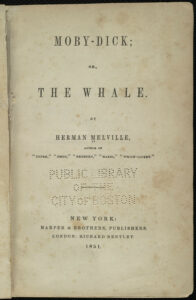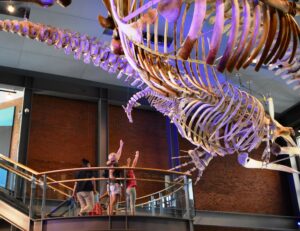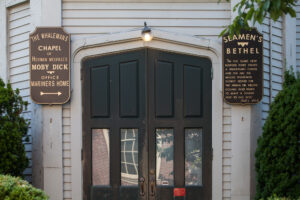By David Wilkening, Contributing Writer

Photo/Courtesy of New Bedford Whaling Museum
NEW BEDFORD – Soon after his latest book was published in 1851, former mariner Herman Melville must have felt like a failure. Little did he know it, but he had written a masterpiece, and his hometown would become world-famous largely because of it.
When Melville returned from the sea to write “Moby-Dick” after 18 months on the whaling ship Acushnet, the writer lived in small but prosperous New Bedford. The population at the time was about 16,000. Because the city is still small today with around 100,000 residents, it has become a popular tourist destination―and easily walkable for most visitors.
They are told that it once was the whaling capital of the world. It has also been called the “city that lit the world” as whale oil fueled many of the lamps of the era. And it was once the wealthiest city on the planet, per capita. It is still dominated by the fishing industry (scallops now), but the link between Melville’s book and the city itself is like Florida and sunshine, or Hollywood and movie stars.
You don’t have to know the whale vs. man story or to have seen the three movie adaptations (the best known is a 1956 John Huston-directed version with Gregory Peck as Captain Ahab) to appreciate the city.
Annual Moby-Dick Marathon
The month of January has a particular emphasis on Melville in New Bedford. Since 1997, the New Bedford Whaling Museum has marked the January departure of Melville from the city to join the whale hunt with its annual Moby-Dick Marathon. This popular annual event, which typically attracts thousands of visitors, will be held virtually this year on January 7 to 9. The event includes one of the world’s best-known readings of the novel, a trivia contest and lectures by Melville scholars.
The story of Melville and his book could make a Hollywood-style movie itself. As they sometimes say in film, the story “was inspired by real events.” There really was a killer albino sperm whale named Mocha Dick who was so aggressive he sank nearly two dozen whaling ships.
The original 752-page hardcover book had a printing in the U.S. of 2,915 copies. That was 1,000 less than the writer’s other three books with Harper & Brothers. It didn’t sell well. It didn’t sell at all.
“Moby-Dick” tells the story of a sailor named Ishmael. He finds himself aboard a whaling ship led by Captain Ahab, a peg-legged man with a single mission: Hunt down and kill the whale that took his leg. But as they chase the ferocious Moby Dick, Ahab’s determination soon descends into madness.
The language in the story was described by reviewers at the time as “biblical and archaic, unceasingly allusive.” Melville earned only $556.37 from the novel. He was forced to return to New York City to spend the rest of his life as an everyday customs inspector.
When he died in 1891 at the age of 72, The New York Times got the name wrong. They called him the author of “Mobie-dick.”
Book is rediscovered after his death

Photo/Courtesy of Boston Public Library, Rare Books & Manuscripts Department
It wasn’t until the centennial of Melville’s birth, 1919, when American biographer and critic Carl Van Doren discovered the book. He bought it at a used bookstore, probably for a few pennies of its first edition cost of $1.50.
Over the following decades, Melville’s “Moby-Dick” was widely recognized as one of the Great American Novels, even to some critics beating out Hemingway, Faulkner and Fitzgerald.
The city of New Bedford is located just under 60 miles from Boston and perhaps somewhat more than an hour’s drive away. It was named after an aristocratic English family. Tourism officials make no bones that its growing appeal in recent years has been based mainly on the faded whaling industry, but also on Melville himself.
Visitors today can find in the city various examples of both the author and the whaling business. The period covered is mainly from the 1820s until whaling’s demise in 1925, when the last whaling ship sailed out of New Bedford harbor. More pure, smokeless whale oil came from New Bedford than from anywhere else on earth. It was used for lamps and other related products.
The city’s top attractions

Photo/Courtesy of New Bedford Whaling Museum
There are three “must-sees” for people interested in not only the industry but also the Melville story. First is the New Bedford Whaling Museum. It has it all―the industry’s art, history, science and culture of South Coast Massachusetts. It has what is termed the world’s largest collection of scrimshaw. It also has the world’s largest whaling ship model. The Lagoda is 89 feet in length with a mainmast of 50 feet. Visitors can board the ship, which was built in 1916. The 750,000 artifacts in the museum’s collection include many products made from whale bones, such as harpoons so sharp that sailors shaved with them, according to Melville.
Metered street parking is available near the museum. Current policy is timed admission, and there are maximum capacity limits.
The second Melville attraction is even more of a bargain: free. Because whaling was a bloody and dangerous business, whalemen were known for their love of saloons and gambling dens. But also churches. So the Quaker-oriented New Bedford Port Society for the Moral Improvement of Seamen started the nondenominational Seamen’s Bethel in 1832. Melville did attend. And the pew he sat in is marked. As for how it looks today, attribute it to the movies.

Photo/Kenneth C. Zirkel CC BY-SA 3.0,
When Melville wrote of the chapel, he describes the pulpit as being suggestive of the front of a ship. But the pulpit when he visited was not prow-shaped; in all probability, it was a typical New England box-style. The New Bedford Port Society listened to the grumblings of disappointed visitors for years before deciding to build a mock-up of the pulpit described in the book and seen in the movie.
Finally, the third stop for Melville fans might be for some comfort food and a brew inspired by the novel. The Moby Dick Brewing Co. is a short walk away. No, Melville did not drink here, because it opened in 2017. But the brewpub’s on-premises-produced draft beer pays tribute to the book. So toast Melville with an Ishm-Ale, an amber ale, The Pulpit, an IPA, or Eye of the Whale, a Scotch ale.
RELATED CONTENT:
Stepping into the past at the homes of two famous writers (fiftyplusadvocate.com)
5 of the best craft breweries in Central Massachusetts to quench any thirst (fiftyplusadvocate.com)
Three simple changes to your RV to help keep you safe on the road (fiftyplusadvocate.com)












